Creative Works
→ Live Visuals / Y2K24 International Live Looping Festival
VJ @ Y2K24 Santa Cruz, CA, November 2024
Oskar Elek as VJ. Festival organized by Rick Walker. Visual production led by David Tristram
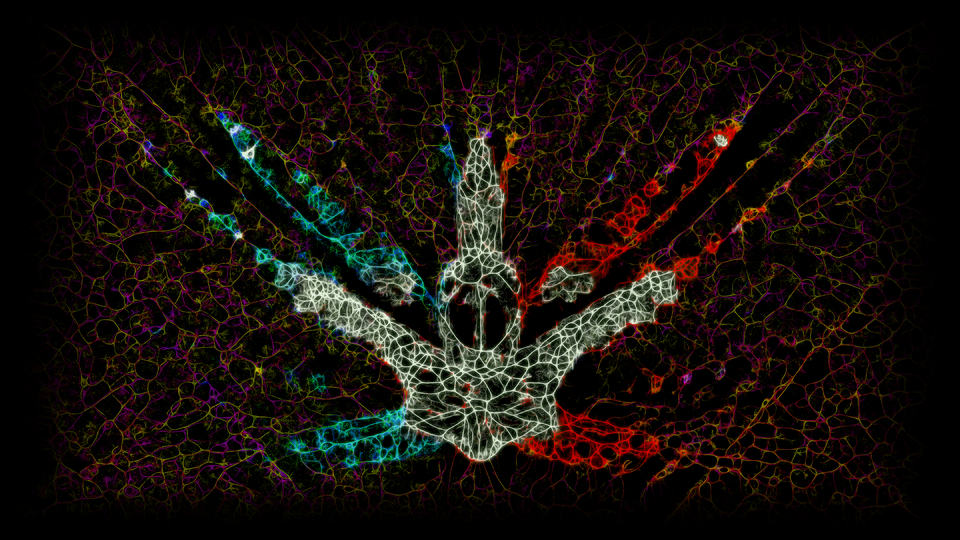
As a VJ at the Y2K24 International Live Looping Festival in Santa Cruz, I had the dynamic role of crafting live, improvised visuals for approximately 30 musical artists. Each performance was a unique fusion of experimental looping music and responsive visual art. Drawing from a palette inspired by biological forms, complex systems, and generative algorithms the visuals unfolded as evolving digital ecosystems. These bio-mimetic patterns and emergent structures were generated and manipulated in real-time, creating a symbiotic relationship with the diverse soundscapes. The festival, a renowned international event founded by Santa Cruz's own Rick Walker, celebrates the art of live looping and fosters a vibrant community of artists. The visual production, supported by the experienced leadership of David Tristram, another Santa Cruz local known for his extensive work in live visuals, provided a stunning backdrop for this convergence of sound and sight.
→ AL-EK: Bio-inspired Visualizations and Synchronized Soundscapes
Live performance @ Indexical, Santa Cruz, Feb 3, 2024
AL-EK: Oskar Elek and Alex Olwal
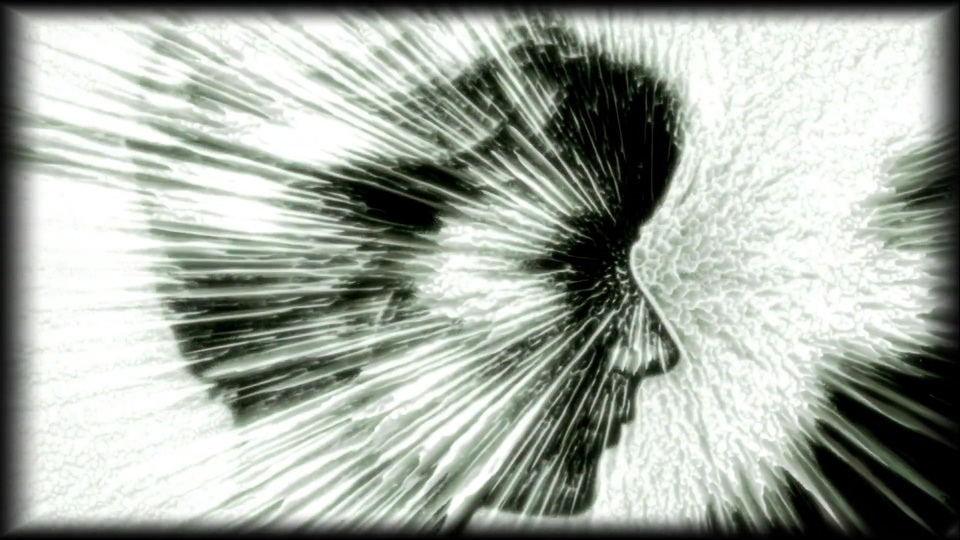
AL-EK is an audiovisual collaboration that crafts bio-inspired visualizations and synchronized soundscapes. The interactions between their generative visuals and electronic compositions lead to emergent expressions through imagery, shapes, and motion rooted in physics and biology. AL-EK embraces the impermanence of modern media to inspire curious dialogue through warped perceptions and sensory provocations.
Oskar is a cross-disciplinary artscientist whose research into complex systems and artificial life informs generative visual representations to invoke new insights into the familiar. Alex shapes frequency and rhythms from diverse ingredients across the electromagnetic spectrum, leveraging electronics, algorithms, instruments, and optics.
→ Generative Visual Programming in Touch Designer
Workshop @ Indexical, February 2024
Oskar Elek (workshop lead), AL-EK (Alex Olwal and Oskar Elek)
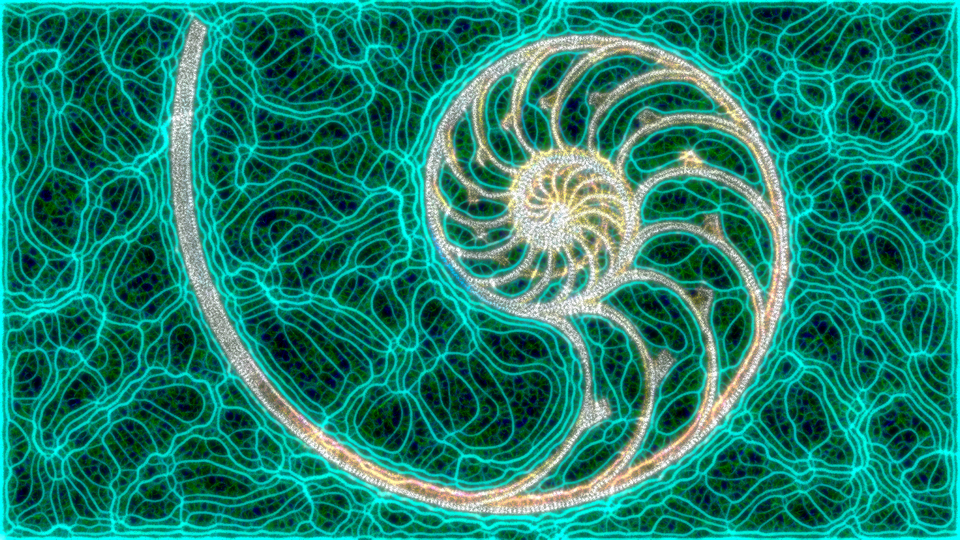
A practical, hands-on dive into the concepts of visual programming interfaces. We will use Touch Designer as the representative system and learn how to build a generative, simulation-driven, real-time VFX pipeline. As the main example we will analyze the visual pipeline used later that day during the AL-EK performance (see event details here: AL-EK at Indexical).
Required Equipment / Materials
To get the most out of the workshop the participants need a decently powerful Windows or MacOS laptop capable of running TouchDesigner (full system requirements here). Prior to the workshop please download and install Touch Designer and activate it under the free non-commercial license. We also encourage everyone to bring headphones and prepare a few samples of visual media they like, such as images, animations and videos.
About the Instructors
AL-EK is Alex Olwal and Oskar Elek. Oskar, who leads this workshop, is a cross-disciplinary artscientist whose research into complex systems and artificial life informs generative visual representations to invoke new insights into the familiar. Alex shapes frequency and rhythms from diverse ingredients across the electromagnetic spectrum, leveraging electronics, algorithms, instruments, and optics.
→ Sonus Stratus / Psynematique
Live performances @ Liminal Space (Northern Lights and Impermanence, 2023)
AL-EK: Oskar Elek and Alex Olwal
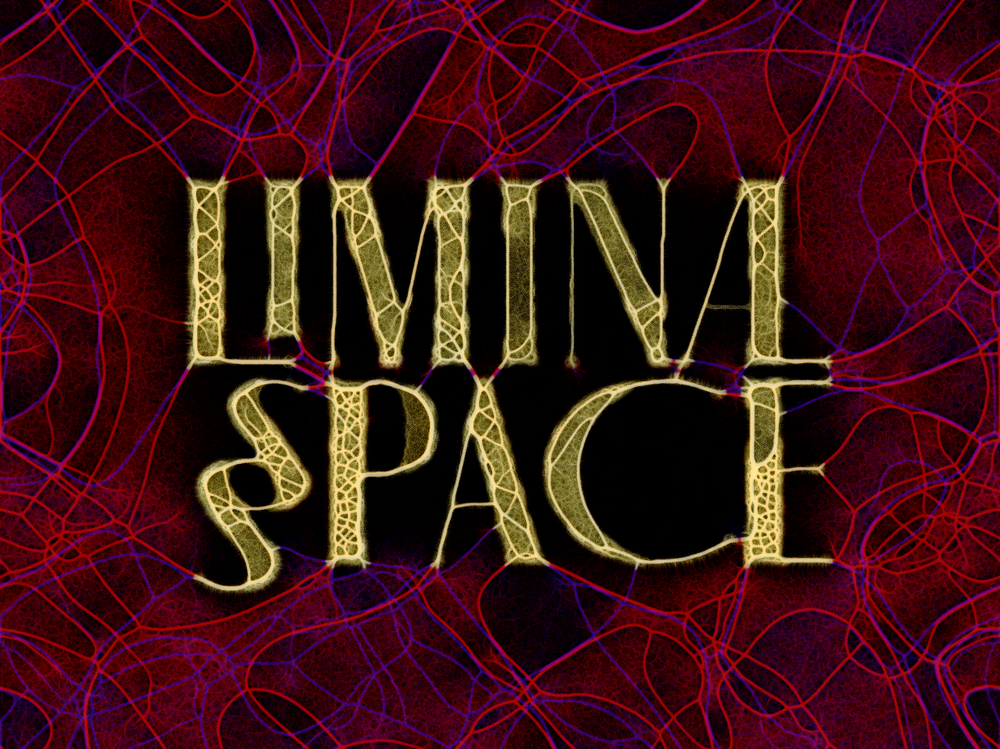
Sonus Stratus and Psynematique are live, partially improvised audio-visual performances delivered in a unique venue: Circle Curch in Santa Cruz, California as part of a series of massive community art events organized by the Liminal Space Collective. In their core nature they are reactive biological visualizations co-habitating and evolving with an improvised electronic score.
Sonus Stratus is derived from the Latin words sonus meaning "sound", and stratus, past participle of sternere which means "to spread". This is a nod to the intertwined nature of the performance, where the generative visual patterns reflect the structure and mood of the musical score, which in turn steers the immediate choices of the musician. The performance thus becomes a dialogue between the performers, leads them to explore unexpected creative paths, and engages the audience in questioning its the nature. Sonus Stratus leads its audience down the path "under": exploring underlying currents of perception and sensation, often ambivalent in their vague resemblance to random everyday experiences.
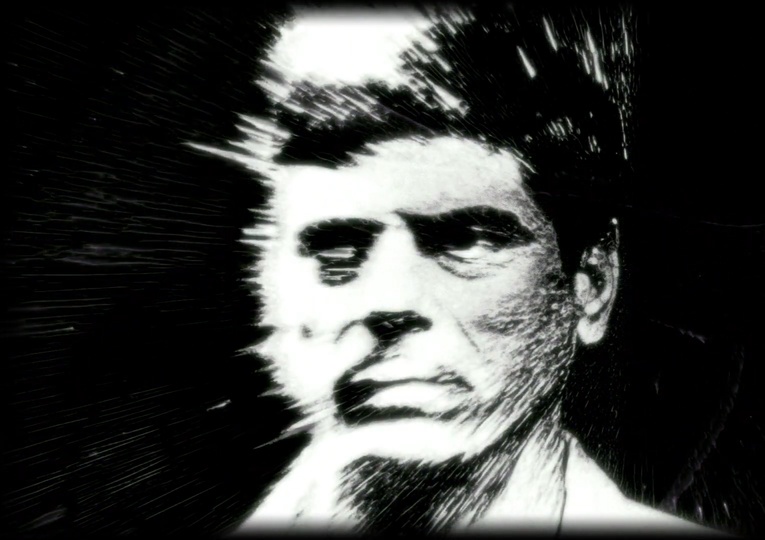
Psynematique is an amalgamation of the prefix psy-, relating to the human psyche and its ability to synthesize (hallucinate) experiences, and cinematique, the French word for "cinematic", anything that relates to the art and craft of motion pictures. This performance is a celebratory homage to old cinematic and animated masterpieces, including La Jetee (1962, see surrounding images), Belladona of Sadness (1973), 7362 (1967), Powers of Ten (1977), Disney animations (early 20th century, that is, before Disney became a faceless mass-culture factory), Salut les Cubains (1946) and others. Using acoustic and visual distortions Psynematique both breaths new life and at the same time deteriorates these old cultural atrifacts, and creates impressionistic audio-visual experiences that the participants often compared to "psychadelic", further reinforcing the title.
These performances are done via an interconnected system of acoustic synthesizers, handheld consoles, computer simulations and audio-visual emitters. Delivered in intimate spaces which allows for at most one-to-two dozen audience members, Sonus Stratus and Psynematique became immersive experiences and also opportunities to communicate about science, technology, art, and their impact on individual lives and health of communities.
![[ICON]](./meta/htm.png) Main Web
Main Web
![[ICON]](./meta/avi.png) Sonus Stratus (capture, recut)
Sonus Stratus (capture, recut)
![[ICON]](./meta/avi.png) Psynematique (video sample)
Psynematique (video sample)
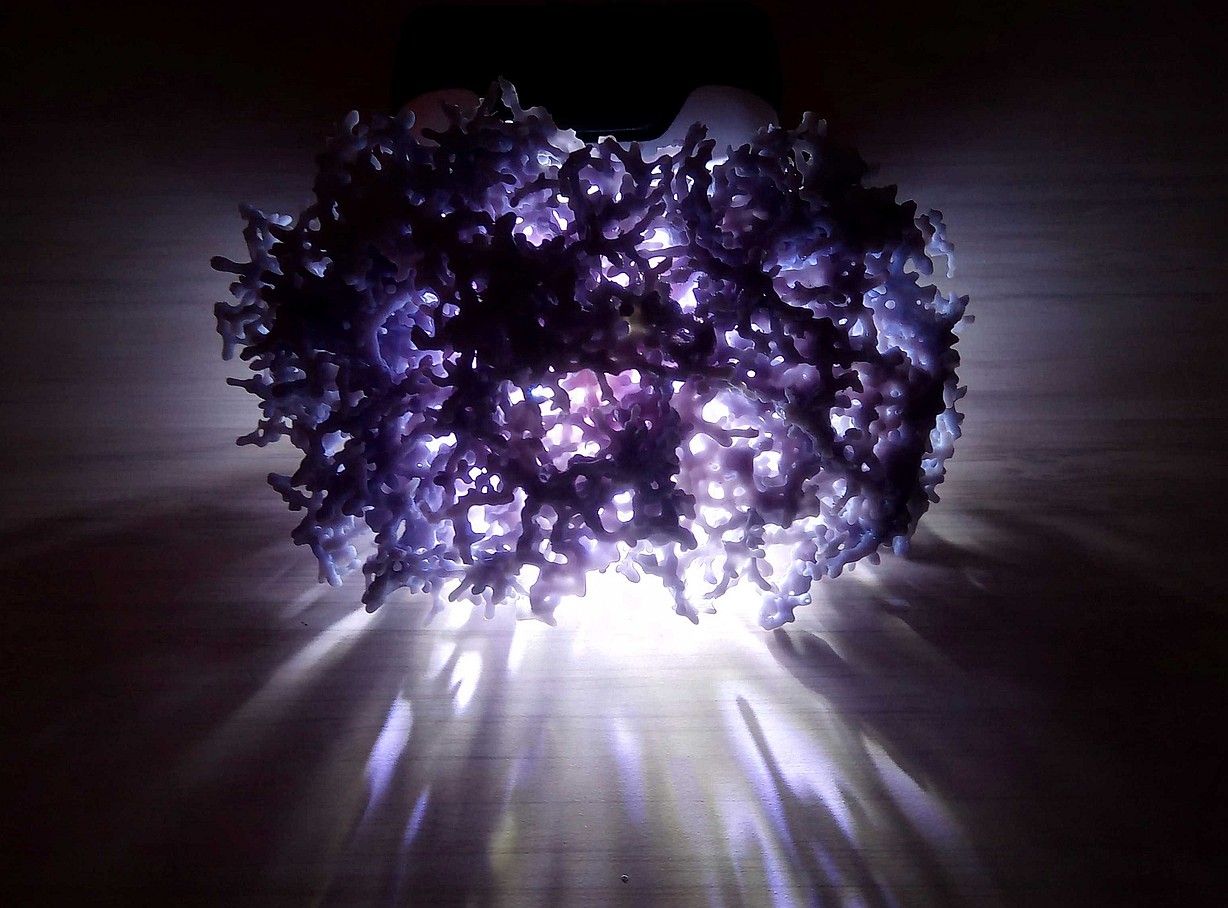
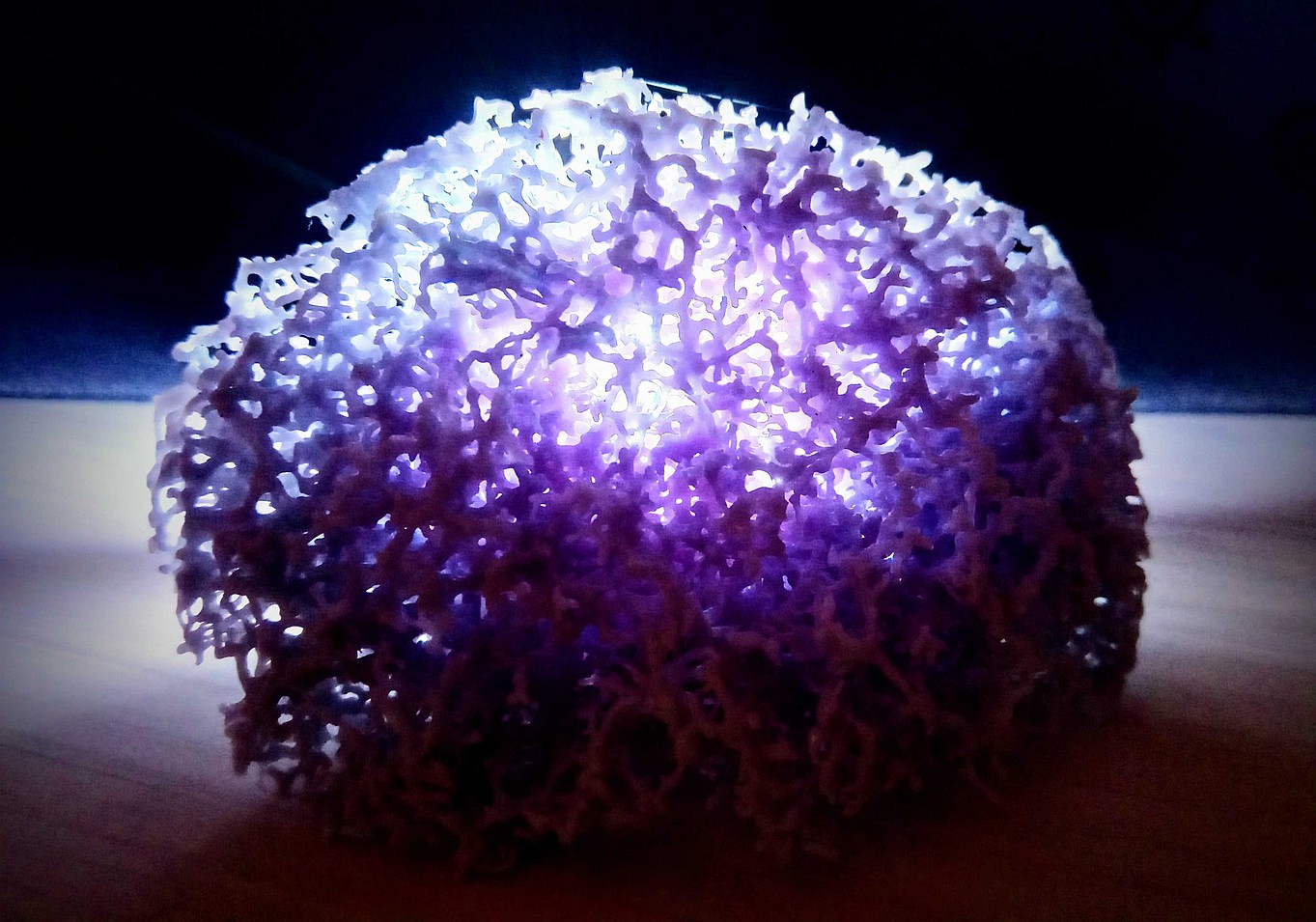
→ Biomimetic 3D Printing
Data Physicalization (2021-23)
Drew Ehrlich and Oskar Elek
Nature presents us with an incredible variety of networked structures: rhizomes formed by tree roots, fungal mycelium networks, animal circulatory systems, and of course, neuron networks.
It seems undeniable that networks are one of the universal structures of reality. Humans construct networks of many kinds, and in 2021 these networks are becoming the dominant part of our lives. Even the Cosmic matter that makes us all is organized in a kind of structured flow that follows the distribution of itself through gravitational interaction.
To give some of these networks physical shape, we use different kinds of 3D printing. For example, stereolitography (SLA) can produce robust structures as long as they are interconnected and don't contain too many overhangs. The pictured prints were generated from 37,000 galaxies from the Sloan Digital Sky Survey catalog. We use PolyPhy to generate continuous scalar field representations of the networks, combined with subsequent meshing and slicing of the data.
This is an ongoing project, please contact us if you're interested to know more or contribute.
→ Sifting Strands
Performance and installation @ VIS Arts Program (October 2022, Oklahoma City)
Oskar Elek, Weston Mossman, Angus G. Forbes
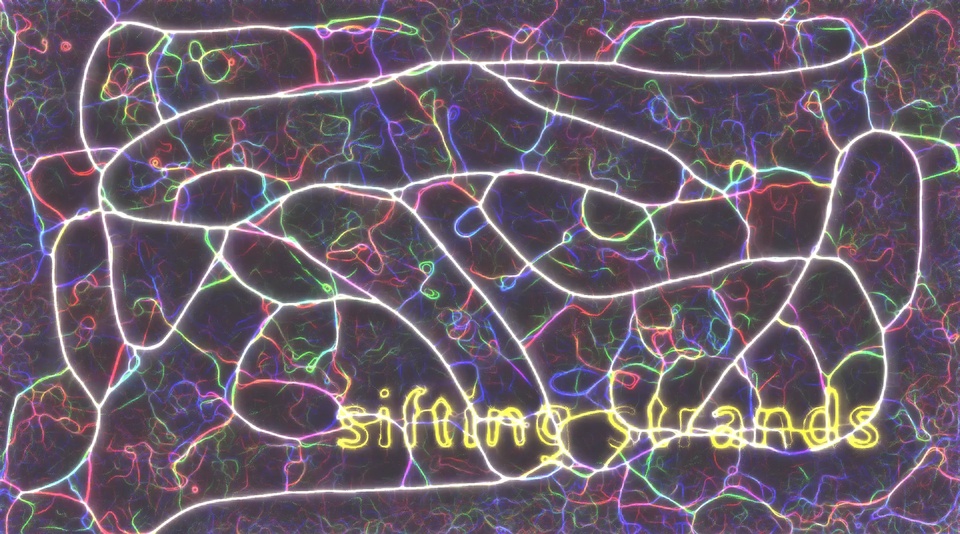
Sifting Strands is a amalgam of a live audio-visual performance and a follow-up interactive instalation, both taking place at the VIS Arts Program 2022 exhibition space in Oklahoma City. The performance combined engaging electronig beats with bio-organic procedural visuals, and has been delivered to an audience of research scientists as well as contemporary artists. Following that experience we offered an immersive installation in which a simulated slime-mold "organism" mirrored the participants and responded to the dynamics of their motion in real time.
The broader context of Sifting Strands is an inter-disciplinary art project which arose from a wider scientific collaboration between computational researchers and astrophysicists. Sifting Sands brings bio-inspired patterns rooted in optimal transport networks into the aesthetic audio-visual realm. In addition to presenting a captivating experience, we explore how compter-generated art and live audience can collaborate in the creative act. The core of the visual side work is a generalized simulation of Physarum polycephalum which meaningfully reacts to music, video and scene depth information (captured by Microsoft Kinect). The underlying computational graph is implemented in Touch Designer and has been adapted to numerous other live performances and interactive installations. Please email Oskar Elek if you'd like to experiment with it.
![[ICON]](./meta/pdf.png) Extended Abstract
Extended Abstract
![[ICON]](./meta/htm.png) VISAP Page
VISAP Page
![[ICON]](./meta/avi.png) Performance (live capture)
Performance (live capture)
![[ICON]](./meta/avi.png) Installation (capture, recut)
Installation (capture, recut)
→ 50 Shapes of Slime
Installation @ Liminal Space (April 2022)
Oskar Elek and Weston Mossman


As the project of Liminal Space grew, constraining it to a traditional performance format no longer felt adequate. With the Santa Cruz based musician Weston Mossman aka Swayor, we reformulated the space into a fair, full of live music, painting, new media and other related endeavors.
50 Shapes of Slime was an interactive installation that brought together dozens of impromptu artists of different skill levels. In this mixed media project a real-time simulation of Physarum polycephalum 'slime mold' (similar to the music-reactive variant) was projected on a surfboard canvas, creating diverse organic patterns. The participants were invited to paint on the surfboard with fluorescent markers, without any explicit instructions. Some chose to follow the patterns generated by the simulation, some ignored them. Either way, the simulation was fed a video capture of the surfboard, and interacted with the participants' drawings. This has created an ongoing structural feedback loop between people and the simulation.
The result of several hours of this collaborative effort is a uniquely painted surfboard exhibited at the place of happening, 11th Hour Coffee in downtown Santa Cruz. While capturing many diverse themes, the drawings share common qualities of chaotic organicity, arguably imprinted by the projected simulation that united the participating artists. This is an attempt at dissolving the boundary between the artist and the medium, distributing the locus of creativity across many minds and the machine.
→ Rhizome Cosmology
Interactive Online Article (Spring 2022)
Oskar Elek, Joseph N. Burchett, Angus G. Forbes

Rhizome Cosmology is created with Polyphorm, an open-source software that combines an interactive implementation of a 3D Physarum machine, and a simultaneous volume visualization of the generated structures.
Polyphorm has enabled novel scientific results through its ability to create detailed 3D density maps of the Cosmic web from sparse cosmological data: catalogues of galaxies and/or dark matter halos. Our main findings include the attribution of a major portion of the intergalactic medium (IGM) to the large-scale filamentary structure of Cosmic web, and an explanation of an unusually large dispersion measure of a so-called fast radio burst (FRB) event.
The value of this project comes from its interdisciplinary nature. By documenting and mapping its story in Rhizome Cosmology through the lens of visualizations, we wish to inspire the curiosity to explore new connections between different scientific disciplines. We also hope that our story will be useful to those who aspire to invent other such methods, in the quest to understand the world — both 'above', and 'below'.
![[ICON]](./meta/htm.png) Rhizome Cosmology (online pictoral article)
Rhizome Cosmology (online pictoral article)
→ Liminal Space
Music-reactive Visual Show @ 11th Hour Coffee (Winter 2022)
Oskar Elek and Weston Mossman

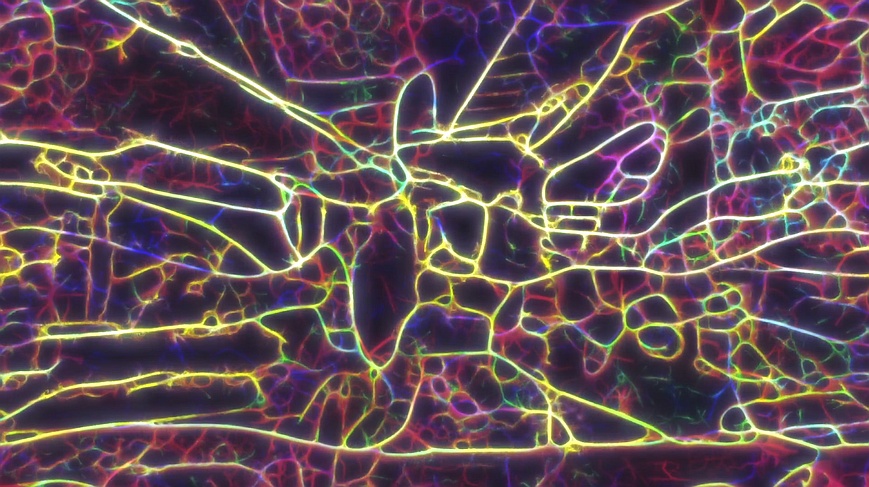
Liminal space is a place of transition. It is a threshold, a locus of searching but not yet knowing. It is a space where flow and transformation takes place.
In collaboration with the Santa Cruz based musician Weston Mossman aka Swayor we have created a series of audio-visual performances in which science meets art. Swayor's soothing ambient electronic music have been complemented by an improvisational, procedurally generated visual show full of patterns and colors. A short clip of this performance is available here and the full recording here. The purpose of Liminal Space is to create an atmosphere of idea melding, where the audience becomes part of the show, whether through playing their own instruments, experimenting with the visual setup, or participating in community art.
On the technical level, the visual aspect of the show is implemented in Touch Designer as a custom compute graph. It implements an expressive variant of the MCPM model which mimics and generalizes the behavior of Physarum polycephalum 'slime mold'. The resulting simulation reacts to music through pulsing and twitching motions, and additionally takes an image input that represents 'food' for the virtual organism. This input can be a simple geometric shape, a video capture of the performance space, or a pre-rendered fractal animation, and we use a combination of all these options throughout the performance.
![[ICON]](./meta/avi.png) Liminal Space (live capture, edited)
Liminal Space (live capture, edited)
→ Physarum Telam
Winner of the Art Award @ Artificial Life (June 2021)
Issei Mori*, Oskar Elek*, Joseph N. Burchett, Angus G. Forbes
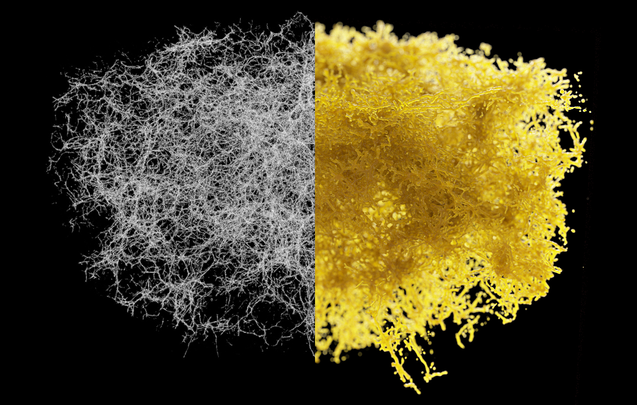
Physarum Telam is an interactive online installation reimagining our team’s research project Polyphorm. Through Physarum Telam we celebrate the slime mold, its awesome weirdness and inexplicable familiarity. For an undifferentiated yellow blob, it boasts remarkable skills: learning, adaptation, navigation. But in spite of these outstanding abilities, it is Physarum’s appearance that makes it instantly recognizable amongst earthly living forms.
In order to reproduce its yellow slimy translucent exterior, we designed a custom physically based appearance model dubbed Slimex. This composite model consists of two components: a glossy surface BSDF representing the organism’s thin transparent membrane and a volumetric scattering model representing the yellow-pigmented cytoplasmic fluid. The images computed by Monte-Carlo path tracing using Slimex provide physically realistic depictions of Physarum, or rather, its imaginary 3D equivalent.
Physarum Telam takes the audience on a tour around the Cosmic Web data generated by Polyphorm. In this interactive online application the observer can freely navigate and examine the data rendered with a standard 3D volume visualization technique called maximum intensity projection, or MIP in short. The style of MIP will be familiar to most, as it is commonly used in medical and scientific 3D visualizations. In addition to the dataset, the visualization also contains several spherical nodes functioning as portals: when clicked, the camera smoothly transitions to the respective node position, and switches to one of the images pre-rendered by Slimex. This novel view of the data reveals to the observer the true nature of its original inspiration: a humble yellow squishy blob with affinity for connecting, for bridging things.
![[HTM]](./meta/htm.png) Physarum Telam (online artwork)
Physarum Telam (online artwork)
![[HTM]](./meta/htm.png) ALIFE Presentation
ALIFE Presentation
![[PDF]](./meta/pdf.png) Extended Abstract
Extended Abstract
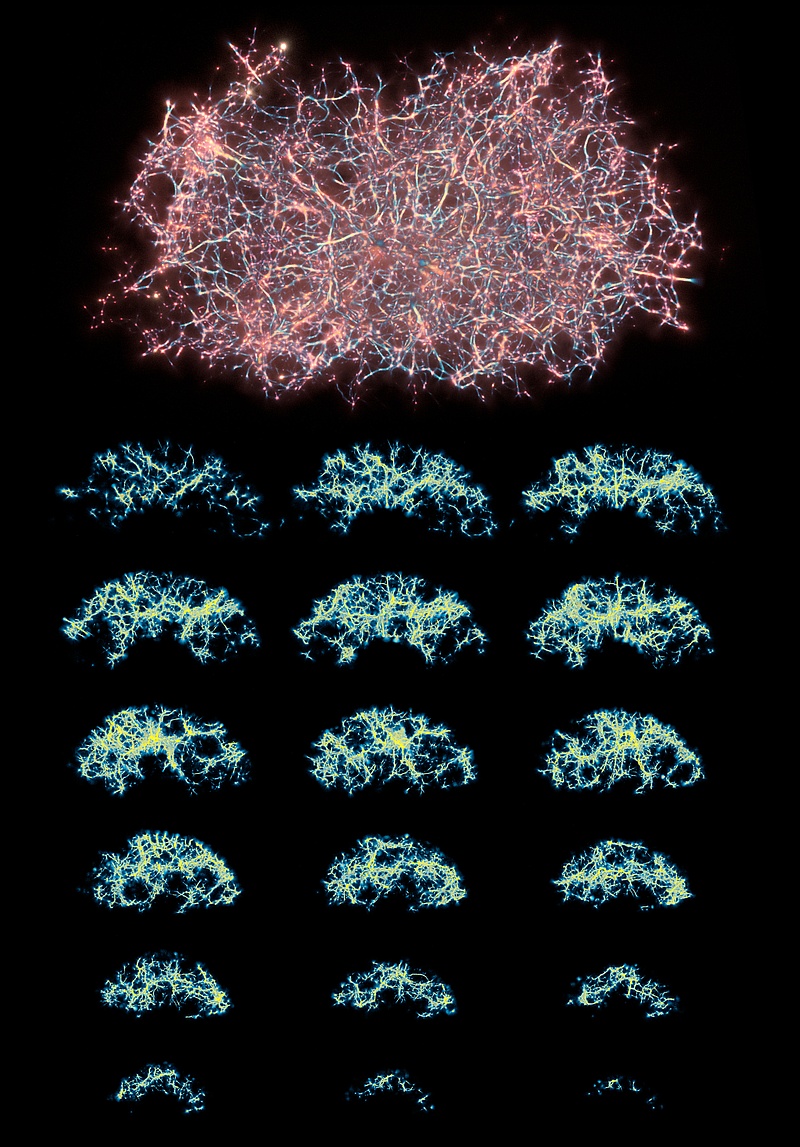
→ As Above - So Below
Digital Print @ MAH Santa Cruz (Spring 2021)
Oskar Elek
The exhibition: In these uncertain times, it's more important than ever to come together to create, celebrate, and heal. The daily lives of people all over the world have changed dramatically in response to the rapid spread of COVID-19. While shelter in place orders have many people spending more time indoors, others continue to live and work outside the home with caution. "In These Uncertain Times" has showcased the creativity and resilience of Santa Cruz County’s response to shelter in place and the COVID-19 global pandemic. Through community-sourced artwork, individual stories and objects from the MAH’s history collection, the exhibition explore the ways that creativity and community can support us through times of uncertainty.
The work: What is our place in a displaced world? How to find connection when our most outstanding shared condition separates us? We set out to answer such questions from a Cosmic perspective. Inspired by nature, we imbued a computer algorithm with the power to connect. The result is a simulation of an ancient organism called Physarum polycephalum ‘slime mold’ applied on a grand scale -- 37,600 galaxies interconnected by tendrils and filaments, joined together in a single vast structure, the Cosmic web. The microscopic and the macroscopic, bridged by universal scale-independent network structures. And with us, humans, right in the middle: slicing the Cosmic web bottom-up, we get images with uncanny resemblance to tomographic scans of our own brain. Again a network, billions of neurons teeming with individual activity, yet united in a desire for place and meaning. Even in uncertain times, we don’t stop looking for connection.
Technical description: The images of the Cosmic web are rendered by a scientific visualization software Polyphorm, developed in 2020 by computational media and astrophysics researchers from UC Santa Cruz. These results have led to several scientific publications in top journals in the fields, expanding our understanding of these (largest known) cosmological structures.
© Oskar Elek. All rights reserved.
![[SLIDES]](./meta/ppt.png) Workshop Slides
Workshop Slides